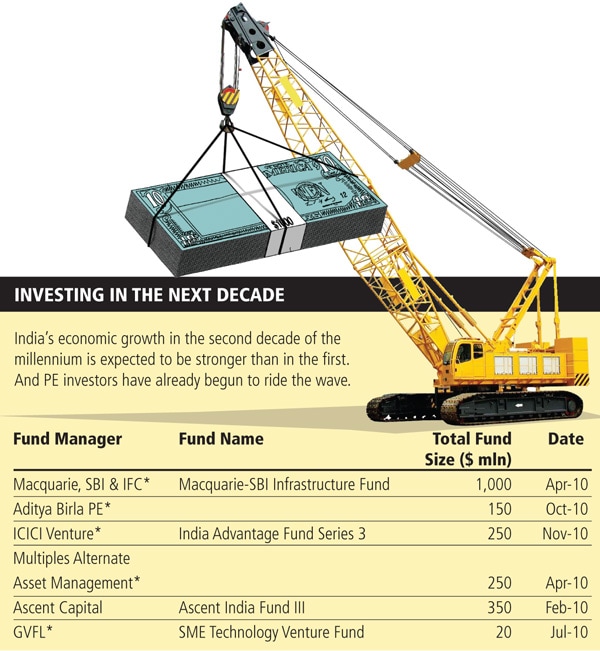
Private Equity: Pricing Imagination
The private equity scene has made a decisive turnaround and HNIs are pouring money in decade-long bets
Time was when the initial public offering of Infosys Technologies struggled to find investors and the lead managers had to underwrite the issue. And what a killing they made! The equity stake they picked up was worth more than 11 times in just seven years despite the dotcom meltdown.
This legend has driven countless investors to try and score the ‘next’ Infosys so that they can retire to a mansion on the hill and live off the stock. The problem is, getting such an opportunity is rather difficult. IPOs are really sought after these days and are normally sold at a hefty premium. Of course, there is the listing gain to enjoy but when has that paid for the mansion? The suits that get a crack at investing in small, private companies are the private equity funds.
So should you look at PE funds as an investment opportunity? The answer is a very guarded and qualified ‘yes’. Go for this option only if you have a large sum — say a crore of rupees — which you can invest and wait at least eight years before you see any money back.
For 2011, stick to funds that aren’t competing with public markets — the ones that are in sectors that aren’t typically available through the listed equities route. “These sectors could be either education or financial inclusion sectors,” says Richa Karpe, director for investments at Altamount Capital, a firm that advises the rich in wealth management.
Through a PE fund, you can invest in upcoming companies in new sectors. Taking a relatively early position in them can fetch very good returns. Very often such companies are in the pre-IPO stage, and need both financial and managerial support, which is provided by the PE fund, and can give higher return than other asset classes. Kushal Desai, managing director, Apar Industries, who also co-founded Apar Technologies, has been investing in PE funds for more than eight years now. He has managed to get a return of more than 25 percent on his money. “I think it is an excellent diversification in the portfolio,” he says.
But here’s why you should be wary: Had Desai merely bought the Sensex basket of stocks 10 years ago, the returns would have been about 400 percent cumulatively! (The BSE Sensex was around 4,000 in the year 2000. Today, it is at 20,000.)
Now comes an even trickier bit. The tax man levies a 20 percent long-term capital gains tax on the sale of unlisted securities. For listed securities, the tax is zero. So, for all the extra risk that you take, not only could you make less than the returns from the public market, you would also pay more taxes! Wait, there is more. Most PE funds charge a 2 percent asset management fee and take 20 percent of the total profits the fund makes; if it does make money that is.
The expectation that stock markets will keep rocketing makes this decision much more difficult.
So let’s stay with the most rational reason. You want to put down money in a PE fund because it diversifies your portfolio. Nitin Deshmukh, head of Kotak Private Equity, as well as Kushal Desai say about 10 percent of the total portfolio in PE would be ideal. 
Infographic: Sameer Pawar
Choose funds that are specialists and invest in sectors where public stock markets don’t offer many options. For instance, Kaizen is a fund that specializes in education and GaJa Capital too has a strong presence there. The other way to go about it is to choose a fund that has a very strong presence in a certain area. Take, for instance, HDFC Real Estate Fund. “This fund is usually the first to be offered an investment opportunity in most of the large and prestigious real estate projects,” says Karpe.
With Great Returns, Comes Great Risk
You have to remember one thing though. This is a highly illiquid piece of investment. Since PE funds invest in unlisted companies, it is hard to sell that investment in a jiffy, should the need arise. You may not see any returns for the next decade. “There is less flexibility to exit and hence needs patient investment. Investing in a PE fund with managers that have a very strong track record is critical, since investors really have no influence on the companies that are being invested in,” says Desai. The fund managers should have seen at least two business cycles. This means the team should have stuck around for at least 10 years. “The level of attrition in PE Industry has been a cause of concern for many investors,” says Rajesh Iyer, head of products and research, Kotak Wealth Management.
One of the key problems with not having experienced managers is valuation goof-up. This is very important today because high levels in the public stock markets are driving valuations steeply in unlisted markets. Deshmukh says there is no P/E ratio in private markets today. “There is P/I or Price-to-Imagination ratio. Promoters’ expectations are very high once again,” he says with a chuckle!
If you make an entry at the wrong price in an unlisted company, you are doomed. It is impossible to average it down and make any decent money off it later. But if you must take this decision, choose a fund that does not invest in very small companies. “Choose PE funds that invest in a combination of pre-IPO and public companies. It increases the probability of steady exits and hence returns to the investors,” says Desai. Godspeed then!
(This story appears in the 30 November, -0001 issue of Forbes India. To visit our Archives, click here.)





